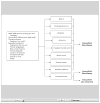Vemurafenib in Multiple Nonmelanoma Cancers with BRAF V600 Mutations
- PMID: 26287849
- PMCID: PMC4971773
- DOI: 10.1056/NEJMoa1502309
Vemurafenib in Multiple Nonmelanoma Cancers with BRAF V600 Mutations
Erratum in
-
Vemurafenib in Multiple Nonmelanoma Cancers with BRAF V600 Mutations; Adjuvant Pertuzumab and Trastuzumab in Early HER2-Positive Breast Cancer.N Engl J Med. 2018 Oct 18;379(16):1585. N Engl J Med. 2018. PMID: 30338958 No abstract available.
Abstract
Background: BRAF V600 mutations occur in various nonmelanoma cancers. We undertook a histology-independent phase 2 "basket" study of vemurafenib in BRAF V600 mutation-positive nonmelanoma cancers.
Methods: We enrolled patients in six prespecified cancer cohorts; patients with all other tumor types were enrolled in a seventh cohort. A total of 122 patients with BRAF V600 mutation-positive cancer were treated, including 27 patients with colorectal cancer who received vemurafenib and cetuximab. The primary end point was the response rate; secondary end points included progression-free and overall survival.
Results: In the cohort with non-small-cell lung cancer, the response rate was 42% (95% confidence interval [CI], 20 to 67) and median progression-free survival was 7.3 months (95% CI, 3.5 to 10.8). In the cohort with Erdheim-Chester disease or Langerhans'-cell histiocytosis, the response rate was 43% (95% CI, 18 to 71); the median treatment duration was 5.9 months (range, 0.6 to 18.6), and no patients had disease progression during therapy. There were anecdotal responses among patients with pleomorphic xanthoastrocytoma, anaplastic thyroid cancer, cholangiocarcinoma, salivary-duct cancer, ovarian cancer, and clear-cell sarcoma and among patients with colorectal cancer who received vemurafenib and cetuximab. Safety was similar to that in prior studies of vemurafenib for melanoma.
Conclusions: BRAF V600 appears to be a targetable oncogene in some, but not all, nonmelanoma cancers. Preliminary vemurafenib activity was observed in non-small-cell lung cancer and in Erdheim-Chester disease and Langerhans'-cell histiocytosis. The histologic context is an important determinant of response in BRAF V600-mutated cancers. (Funded by F. Hoffmann-La Roche/Genentech; ClinicalTrials.gov number, NCT01524978.).
Figures



Comment in
-
Let's Not Put All Our Eggs in One Basket.N Engl J Med. 2015 Aug 20;373(8):691-3. doi: 10.1056/NEJMp1508144. N Engl J Med. 2015. PMID: 26287847 No abstract available.
-
Melanoma Drug Works in Other Tumors.Cancer Discov. 2015 Nov;5(11):1117. doi: 10.1158/2159-8290.CD-NB2015-131. Epub 2015 Sep 18. Cancer Discov. 2015. PMID: 26385779
References
-
- Davies H, Bignell GR, Cox C, et al. Mutations of the BRAF gene in human cancer. Nature. 2002;417:949–54. - PubMed
-
- Curtin JA, Fridlyand J, Kageshita T, et al. Distinct sets of genetic alterations in melanoma. N Engl J Med. 2005;353:2135–47. - PubMed
-
- Van Cutsem E, Köhne CH, Láng I, et al. Cetuximab plus irinotecan, fluorouracil, and leucovorin as first-line treatment for metastatic colorectal cancer: updated analysis of overall survival according to tumor KRAS and BRAF mutation status. J Clin Oncol. 2011;29:2011–9. - PubMed
Publication types
MeSH terms
Substances
Associated data
Grants and funding
LinkOut - more resources
Full Text Sources
Other Literature Sources
Medical
Molecular Biology Databases
Research Materials
